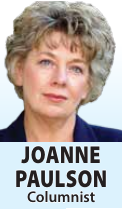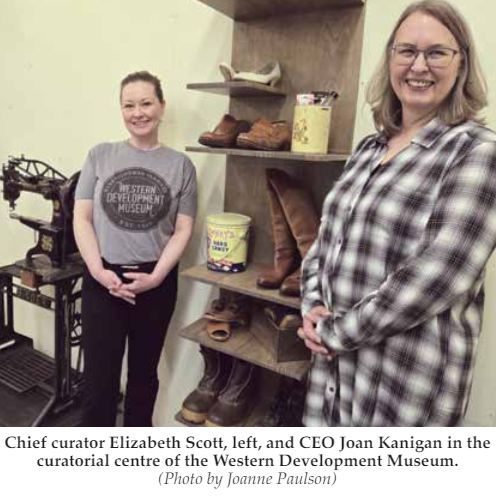
The Western Development Museum’s curatorial centre, across Lorne Avenue from the Saskatoon museum itself, is quite literally entirely packed to the rafters with artifacts. Which is saying something, because the building is huge and the ceilings do soar. There’s farm machinery. A big old bus. Furniture of every kind. Dolls. Shoes. Jukeboxes. An ambulance. They range in size from tiny thimbles, pins and coins up to the rather large grain elevator at the North Battleford location. The list would fill an entire book: there are 75,000 artifacts in the centre and across the four WDM locations, a number that reflects the museum’s 75th anniversary 1,000 times. “Museums are the collective memory of our communities,” said WDM CEO Joan Kanigan in an interview. “Being able to share those tangible pieces of our cultural heritage is a way of creating memory and a sense of belonging and that community identity that is so critical to having a cohesive, engaged civil society. “Museums really play an important role in creating space where people can see themselves reflected in their community’s history, can feel they’re a part of that history. “That’s something we strive to do at the Western Development Museum.”

Kanigan and chief curator Elizabeth Scott, who both joined the WDM in 2016, are working to expand those stories told at the four WDMs. “When the legislation that created the WDM was passed, our founders had a really broad vision for what the museum would do – basically the economic and cultural development of Western Canada,” Kanigan said. “We like to tie into our provincial motto, “From many peoples, strength,’ because it reflects what we are trying to do at the WDM.” Scott noted that the WDM is well-known for its world-class agricultural collection, but the museum has always worked toward diversity in its collection. “There is something incredible about standing beside a huge, 100-year-old threshing machine,” Scott said. “But really since the beginning, we’ve collected artifacts about innovation (and) our domestic collection has all kinds of interesting artifacts about women and children, for example. “Where we have had underrepresentation is whose stories those represent. “That’s what we’re trying to do today with our new collections development plan, is diversify whose stories those are.” “We’re not taking away from what we’ve told in the past,” Kanigan added. “We’re adding to and enriching and expanding what people can see and experience and learn about in the WDM. It’s very exciting.” “It’s very fun, too,” Scott said.
The WDM has locations in Saskatoon, Moose Jaw, North Battleford and Yorkton, and “every location is different. It’s a completely different experience (at each one),” Kanigan said. In celebration of the anniversary, in fact, the WDM has created a special passport: if you visit all four locations and get your ‘stamps,’ you can enter a draw to be made April 2, 2025. The WDM has also produced commemorative t-shirts and will be holding a gala sometime in the fall. In part because there are four locations, 35 per cent of the collection is on display at any given time, which is very high for a museum; the average is 10 to 15 per cent. “It’s been important to the museum from the beginning to exhibit the collection,” Scott said. “When you look at our early World War air hangars where we used to display our collection, the way we see that in photographic record, it’s quite clear that was very important to the founders, to make the collection accessible.”
The WDM has always been funded by provincial government, today at the level of 70 per cent; the remainder is generated through fundraising, grants and sales. It’s a stable level of funding “not a lot of museums get to enjoy,” Kanigansaid. While that hasn’t changed, some things have — such as technology. “In the 2024 context, that means virtual exhibits now and some great programs in that outreach space, like Seniors Without Walls (in Moose Jaw),” Scott said. And striving for diversity is taking on a bigger role. “We are really striving to embody Saskatchewan’s diverse cultural heritage,” Kanigan said. “We want to be able to inspire curiosity in our shared histories. The more we get to know each other and understand each other’s experiences and histories . . . it breaks down all of those barriers.” To that end, they are working on developing good partnerships in the community, which is “absolutely essential to working with Indigenous communities and others that have been underrepresented,” said Kanigan. “We really try to model the value of ‘nothing about us without us,’” she said. “We want to . . . create space for community members to say, this is what we want to share, and this is how we want to be represented. “And that takes time, because you have to build trust.”
An example of this approach is the relatively new exhibit, Wapaha Ska Oyate: Living Our Culture, Sharing Our Community at Pion-Era, produced jointly with the Whitecap Dakota First Nation in the spirit of reconciliation and now on permanent display in Saskatoon. Whitecap had complete say over the curatorial vision of the new exhibit, said Kanigan. “Right down to paint colour,” Scott added.
-Joanne Paulson

Leave a Reply